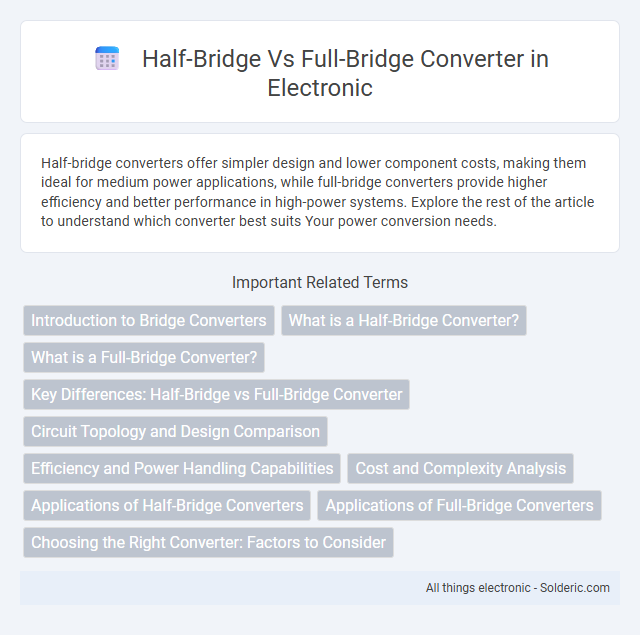Half-bridge converters offer simpler design and lower component costs, making them ideal for medium power applications, while full-bridge converters provide higher efficiency and better performance in high-power systems. Explore the rest of the article to understand which converter best suits Your power conversion needs.
Comparison Table
| Feature | Half-Bridge Converter | Full-Bridge Converter |
|---|---|---|
| Topology | Uses two switches and two capacitors forming a midpoint | Uses four switches arranged in an H-bridge configuration |
| Output Voltage | Half of the input voltage | Full input voltage applied to the load |
| Power Handling | Moderate power levels | Higher power capability |
| Switching Complexity | Lower; fewer switches and simpler control | Higher; more switches and complex timing control |
| Efficiency | Good efficiency with simpler design | Higher efficiency at high power due to better utilization |
| Applications | Medium power supplies, LED drivers | High power motor drives, industrial power supplies |
| Cost | Lower cost due to fewer components | Higher cost due to more switches and complex design |
| Transformer Utilization | Uses only half of the transformer winding | Full utilization of transformer winding |
Introduction to Bridge Converters
Bridge converters are essential components in power electronics, used to efficiently convert DC to AC power or vice versa. Half-bridge converters utilize two switches and operate with a midpoint capacitor, offering simplicity and cost-effectiveness for moderate power applications. Full-bridge converters employ four switches to achieve higher power handling and improved voltage utilization, making them suitable for demanding industrial and renewable energy systems.
What is a Half-Bridge Converter?
A Half-Bridge Converter is a type of DC-DC converter that uses two switches and two capacitors to efficiently step up or step down voltage in power electronics applications. This converter topology balances voltage stress across components and provides good power transfer efficiency, making it suitable for medium-power applications. Understanding how a Half-Bridge Converter operates helps you select the right solution for your power conversion needs.
What is a Full-Bridge Converter?
A Full-Bridge Converter is a type of DC-DC converter that utilizes four switching devices arranged in an H-bridge configuration to efficiently control power flow and achieve high voltage conversion ratios. It offers improved power handling and reduced harmonic distortion compared to Half-Bridge Converters, making it suitable for high-power applications such as motor drives and renewable energy systems. The full-bridge topology enables bidirectional power flow and greater control over output voltage and current waveforms.
Key Differences: Half-Bridge vs Full-Bridge Converter
Half-bridge converters use two switches and two capacitors to divide the input voltage, offering simpler design and lower component count compared to full-bridge converters which employ four switches to deliver the full voltage to the load. Full-bridge converters provide higher power output and improved efficiency by enabling bidirectional current flow and reducing voltage stress on switches. The choice between half-bridge and full-bridge converters depends on power requirements, efficiency targets, and complexity constraints in applications such as power supplies and motor drives.
Circuit Topology and Design Comparison
Half-bridge converters utilize two switches and two capacitors to create a midpoint voltage, offering a simpler circuit topology with fewer components and lower cost. Full-bridge converters employ four switches arranged in an H-bridge configuration, enabling higher power handling and better voltage utilization through bipolar switching. Your choice between these designs depends on power requirements, efficiency, and complexity constraints.
Efficiency and Power Handling Capabilities
Half-bridge converters offer moderate efficiency and power handling, typically suitable for mid-range applications up to a few kilowatts, due to reduced voltage stress and simpler transformer design. Full-bridge converters provide higher efficiency and superior power handling capabilities, often supporting power levels from several kilowatts to megawatts, by enabling full utilization of the transformer winding and reducing conduction losses through balanced current flow. Efficiency in full-bridge designs can exceed 95%, making them ideal for high-power and industrial applications where maximum performance and reliability are critical.
Cost and Complexity Analysis
Half-bridge converters generally offer lower cost and reduced complexity due to fewer components such as switches and capacitors compared to full-bridge converters. Full-bridge converters, while more complex with four switches and intricate control circuitry, provide higher power output and better efficiency in high-power applications. The trade-off between cost and complexity versus performance makes half-bridge converters suitable for medium power levels and full-bridge converters ideal for demanding, high-power environments.
Applications of Half-Bridge Converters
Half-bridge converters are widely used in medium-power applications such as DC-DC converters, motor drives, and uninterruptible power supplies (UPS), providing efficient voltage regulation and isolation. Their design offers a balance between cost, complexity, and performance, making them suitable for applications requiring moderate power levels and lower electromagnetic interference. You can find half-bridge converters in renewable energy systems and industrial power supplies where reliable and compact power conversion is crucial.
Applications of Full-Bridge Converters
Full-bridge converters are widely used in high-power applications such as industrial motor drives, electric vehicles, and renewable energy systems due to their ability to provide higher voltage output and improved efficiency. They are ideal for DC-DC conversion in power supplies for telecommunications and data centers, offering precise voltage regulation and reduced electromagnetic interference. Full-bridge topologies enable bidirectional power flow, making them suitable for energy storage systems and grid-tied inverters.
Choosing the Right Converter: Factors to Consider
Selecting the right converter between half-bridge and full-bridge involves evaluating power requirements, efficiency, and complexity. Half-bridge converters are suitable for medium power applications with moderate efficiency and simpler design, while full-bridge converters provide higher power capacity and greater efficiency but with increased complexity and cost. Consider factors like voltage levels, switching frequency, thermal management, and load characteristics to optimize converter performance and reliability in your specific application.
Half-Bridge vs Full-Bridge Converter Infographic

 solderic.com
solderic.com